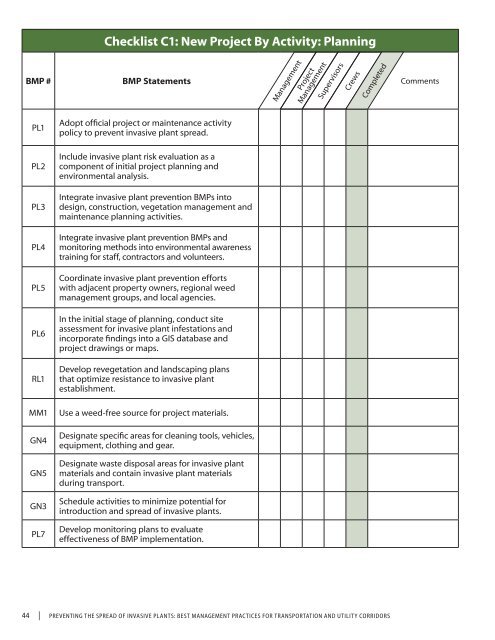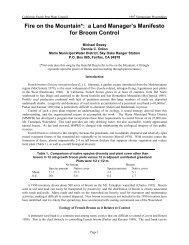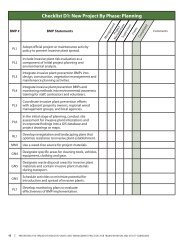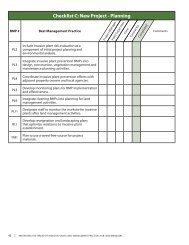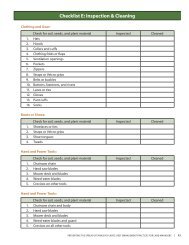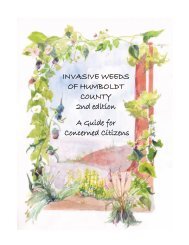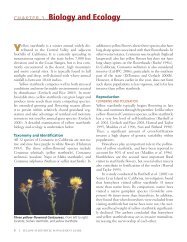Checklist C1: New Project By Activity: Planning - Cal-IPC
Checklist C1: New Project By Activity: Planning - Cal-IPC
Checklist C1: New Project By Activity: Planning - Cal-IPC
You also want an ePaper? Increase the reach of your titles
YUMPU automatically turns print PDFs into web optimized ePapers that Google loves.
<strong>Checklist</strong> <strong>C1</strong>: <strong>New</strong> <strong>Project</strong> <strong>By</strong> <strong>Activity</strong>: <strong>Planning</strong><br />
<strong>Project</strong><br />
Management<br />
Supervisors<br />
BMP # BMP Statements Comments<br />
Management<br />
Crews<br />
Completed<br />
PL1<br />
PL2<br />
PL3<br />
PL4<br />
PL5<br />
PL6<br />
RL1<br />
MM1<br />
GN4<br />
GN5<br />
GN3<br />
PL7<br />
Adopt official project or maintenance activity<br />
policy to prevent invasive plant spread.<br />
Include invasive plant risk evaluation as a<br />
component of initial project planning and<br />
environmental analysis.<br />
Integrate invasive plant prevention BMPs into<br />
design, construction, vegetation management and<br />
maintenance planning activities.<br />
Integrate invasive plant prevention BMPs and<br />
monitoring methods into environmental awareness<br />
training for staff, contractors and volunteers.<br />
Coordinate invasive plant prevention efforts<br />
with adjacent property owners, regional weed<br />
management groups, and local agencies.<br />
In the initial stage of planning, conduct site<br />
assessment for invasive plant infestations and<br />
incorporate findings into a GIS database and<br />
project drawings or maps.<br />
Develop revegetation and landscaping plans<br />
that optimize resistance to invasive plant<br />
establishment.<br />
Use a weed-free source for project materials.<br />
Designate specific areas for cleaning tools, vehicles,<br />
equipment, clothing and gear.<br />
Designate waste disposal areas for invasive plant<br />
materials and contain invasive plant materials<br />
during transport.<br />
Schedule activities to minimize potential for<br />
introduction and spread of invasive plants.<br />
Develop monitoring plans to evaluate<br />
effectiveness of BMP implementation.<br />
44 | Preventing the Spread of Invasive Plants: Best Management Practices for Transportation and Utility Corridors
<strong>Checklist</strong> C2: <strong>New</strong> <strong>Project</strong> <strong>By</strong> <strong>Activity</strong>: Vegetation Management<br />
<strong>Project</strong><br />
Management<br />
Supervisors<br />
BMP # BMP Statements Comments<br />
Management<br />
Crews<br />
Completed<br />
GN1<br />
GN2<br />
VM1<br />
VM2<br />
GN4<br />
GN5<br />
GN6<br />
GN7<br />
VM4<br />
GN8<br />
GN9<br />
VM3<br />
VM5<br />
GN11<br />
PL7<br />
Provide prevention training and appropriate<br />
invasive plant identification resources to staff and<br />
contractors prior to starting work.<br />
Scout for invasive plants and evaluate risks before<br />
activities begin.<br />
Schedule vegetation management activities to<br />
maximize the effectiveness of control efforts and<br />
minimize introduction and spread of invasive plants.<br />
Develop a mowing policy to minimize the<br />
introduction and spread of invasive plants.<br />
Designate specific areas for cleaning tools, vehicles,<br />
equipment, clothing and gear.<br />
Designate waste disposal areas for invasive plant<br />
materials and contain invasive plant materials<br />
during transport.<br />
Plan travel routes to avoid areas infested with<br />
invasive plants.<br />
Clean tools, equipment, vehicles and animals<br />
to remove soil, seeds and plant parts before<br />
transporting materials and before entering and<br />
leaving worksites.<br />
Keep livestock and support animals clean.<br />
Clean clothing, footwear and gear to remove soil,<br />
seeds and plant parts before leaving infested areas.<br />
Prepare worksites to limit the introduction and<br />
spread of invasive plants.<br />
Retain existing desirable vegetation and canopy<br />
where possible.<br />
Render invasive plant material nonviable when<br />
disposing of materials on-site.<br />
After activities, monitor worksites for invasive<br />
plants.<br />
Evaluate effectiveness of BMP implementation.<br />
Preventing the Spread of Invasive Plants: Best Management Practices for Transportation and Utility Corridors | 45
<strong>Checklist</strong> C3: <strong>New</strong> <strong>Project</strong> <strong>By</strong> <strong>Activity</strong>: Soil Disturbance<br />
<strong>Project</strong><br />
Management<br />
Supervisors<br />
BMP # BMP Statements Comments<br />
Management<br />
Crews<br />
Completed<br />
GN1<br />
GN2<br />
GN3<br />
GN4<br />
GN5<br />
GN6<br />
GN7<br />
GN8<br />
GN9<br />
MM1<br />
MM2<br />
SD1<br />
SD2<br />
SD3<br />
VM5<br />
GN11<br />
PL7<br />
Provide prevention training and appropriate<br />
invasive plant identification resources to staff and<br />
contractors prior to starting work.<br />
Scout for invasive plants and evaluate risks before<br />
activities begin.<br />
Schedule activities to minimize potential for<br />
introduction and spread of invasive plants.<br />
Designate specific areas for cleaning tools, vehicles,<br />
equipment, clothing and gear before starting work.<br />
Designate waste disposal areas for invasive plant<br />
materials and contain invasive plant materials<br />
during transport.<br />
Plan travel routes to avoid areas infested with<br />
invasive plants.<br />
Clean tools, equipment, vehicles and animals<br />
to remove soil, seeds and plant parts before<br />
transporting materials and before entering and<br />
leaving worksites.<br />
Clean clothing, footwear and gear to remove soil,<br />
seeds and plant parts before leaving infested areas.<br />
Prepare worksites to limit the introduction and<br />
spread of invasive plants.<br />
Use a weed-free source for project materials.<br />
Prevent invasive plant contamination of project<br />
materials when stockpiling and during transport.<br />
Minimize soil disturbance and transport during<br />
project implementation.<br />
Implement erosion control practices.<br />
Manage existing topsoil and duff material.<br />
Render invasive plant material nonviable when<br />
disposing of materials on-site.<br />
After activities, monitor worksites for invasive<br />
plants.<br />
Evaluate effectiveness of BMP implementation.<br />
46 | Preventing the Spread of Invasive Plants: Best Management Practices for Transportation and Utility Corridors
<strong>Checklist</strong> C4: <strong>New</strong> <strong>Project</strong> <strong>By</strong> <strong>Activity</strong>: Revegetation & Landscaping<br />
<strong>Project</strong><br />
Management<br />
Supervisors<br />
BMP # BMP Statements Comments<br />
Management<br />
Crews<br />
Completed<br />
GN1<br />
GN2<br />
RL1<br />
GN3<br />
GN4<br />
GN5<br />
GN6<br />
GN7<br />
GN8<br />
GN9<br />
VM3<br />
MM1<br />
MM2<br />
RL2<br />
GN10<br />
RL3<br />
GN11<br />
PL7<br />
Provide prevention training and appropriate<br />
invasive plant identification resources to staff and<br />
contractors prior to starting work.<br />
Scout for invasive plants and evaluate risks before<br />
activities begin.<br />
Develop revegetation and landscaping plans that<br />
optimize resistance to invasive plant establishment.<br />
Schedule activities to minimize potential for<br />
introduction and spread of invasive plants.<br />
Designate specific areas for cleaning tools, vehicles,<br />
equipment, clothing and gear.<br />
Designate waste disposal areas for invasive plant<br />
materials and contain invasive plant materials<br />
during transport.<br />
Plan travel routes to avoid areas infested with<br />
invasive plants.<br />
Clean tools, equipment, vehicles and animals<br />
to remove soil, seeds and plant parts before<br />
transporting materials and before entering and<br />
leaving worksites.<br />
Clean clothing, footwear and gear to remove soil,<br />
seeds and plant parts before leaving infested areas.<br />
Prepare worksite to limit the introduction and<br />
spread of invasive plants.<br />
Retain desirable vegetation and canopy where<br />
possible to increase competition for invasive plants.<br />
Use a weed-free source for project materials.<br />
Prevent invasive plant contamination of project<br />
materials when stockpiling and during transport.<br />
Acquire plant materials locally. Inspect delivered<br />
plants to ensure plant labels match specifications<br />
prior to planting.<br />
Minimize soil and vegetation disturbance.<br />
Revegetate and/or mulch disturbed soils as soon as<br />
possible.<br />
After activities, monitor worksites for invasive<br />
plants.<br />
Evaluate effectiveness of BMP implementation.<br />
Preventing the Spread of Invasive Plants: Best Management Practices for Transportation and Utility Corridors | 47
Key to BMP Chapter Acronymns<br />
GN – General BMPs, Chapter 1, page 9<br />
MM – Materials Management, Chapter 3 , page 21<br />
PL – <strong>Planning</strong>, Chapter 2 , page 17<br />
RL – Revegetation and Landscaping, Chapter 6 , page 31<br />
RM – Routine Maintenance, Chapter 7 , page 35<br />
SD – Soil Disturbance, Chapter 5 , page 29<br />
VM – Vegetation Management, Chapter 4 , page 25<br />
40 | Preventing the Spread of Invasive Plants: Best Management Practices for Transportation and Utility Corridors


